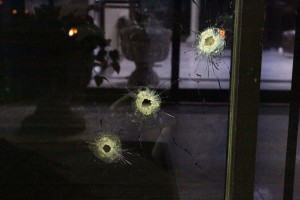Bullets riddled El Diario’s front door, but the newspaper’s spirit is unscathed
|
EL PASO – A group of armed men in a grey van approached the premises of El Diario de Ciudad Juárez, the leading newspaper in the city now ranked as the 19th most dangerous in the world, and fired seven bullets through the building’s plate-glass door before dawn on March 6. “There was never a previous threat or any kind of vindictive message. We did not expect it… so far the authorities have not been able to tell us who it was or what was the motive,” said Pedro Torres, Associate Editor of El Diario de Juárez. The early morning attack was not the newspaper’s first encounter with violence. Armando Rodríguez, the lead crime reporter for El Diario, was shot to death in November 2008.
